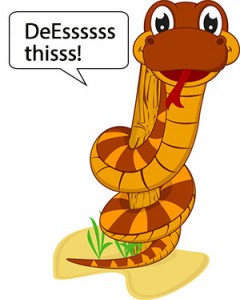 The term “deEss” or “de-ess” refers to editing an audio recording – usually of a voice – when the “S” (and sometimes “sh” and “th,” etc.) sounds (technically called “sibilance”) seem much too loud in relation to to rest of the vocal. It involves trying to reduce the volume or energy of JUST the S sound while leaving the rest of the vocal alone. There is a specific kind of audio editing tool for this, called a “DeEsser.” See my article How to Fix SSS-Sibilance in Your Audio With Sound Editing Software for the basics on sibilance and deEssers.
The term “deEss” or “de-ess” refers to editing an audio recording – usually of a voice – when the “S” (and sometimes “sh” and “th,” etc.) sounds (technically called “sibilance”) seem much too loud in relation to to rest of the vocal. It involves trying to reduce the volume or energy of JUST the S sound while leaving the rest of the vocal alone. There is a specific kind of audio editing tool for this, called a “DeEsser.” See my article How to Fix SSS-Sibilance in Your Audio With Sound Editing Software for the basics on sibilance and deEssers.
But there are other ways to tame those sibilant sounds. Below is a post from Audio Geek Zine with some ideas on several different ways to do it. This article is extra cool since it uses Reaper for the examples. Our course, The Newbies Guide To Audio Recording Awesomeness 2: Pro Recording With Reaper, shows you how to use Reaper to record and produce professional audio projects. I used Reaper in that course because that is my go-to recording software. The concepts taught, however, are certainly just as applicable to any other recording program.
Anyway, I digress. The article I mentioned about different ways to de-ess (deEss, whatever) a vocal is here:
http://audiogeekzine.com/2013/07/advanced-deessing-techniques/
EQ
Filter The Mourning Dove Hoot Out Of The Voiceover Recording
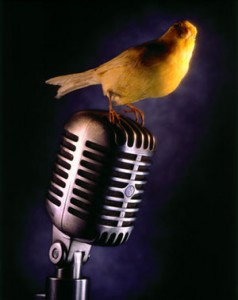 I was working on a long voiceover recording job last week. After it was all recorded, I began the long process of editing it for the client. That involved not only optimizing the volume and minimizing the noise, but also creating 27 separate files. Things were progressing nicely, but then I heard an odd sound behind the voice at one point. You can probably guess by the title of the post what that sound was. Sigh.
I was working on a long voiceover recording job last week. After it was all recorded, I began the long process of editing it for the client. That involved not only optimizing the volume and minimizing the noise, but also creating 27 separate files. Things were progressing nicely, but then I heard an odd sound behind the voice at one point. You can probably guess by the title of the post what that sound was. Sigh.
Keep in mind that most voiceover jobs do not involve multitrack recording. That is to say, there is only one single track of audio being recorded. So if you hear a bird’s hoot AND your voice together on the recording, you can’t just “delete” the bird sound. In multitrack recording – such as you would use for most music recording – you purposely put different sounds on their own tracks so you can adjust the volume of each sound until it all mixes together nicely. THEN you render (mix down) the result to a single file. But I did not have the luxury of simply turning down the bird hoot. How in the world do I get rid of it?
OK, sure. I could just re-record that part when the bird is NOT outside my window. But that smacks of effort. I like to do things the easy way if I can. Yes, you may substitute the word “lazy” into that last sentence:-P. Anyway, there are some audio editing tools that you can use to reduce (or even eliminate) one type of sound, while leaving the desired audio alone. One of the best of these tools is EQ (short for “equalization”).
If the undesired audio has a much different frequency than the desired audio, then EQ can help filter out what you don’t want to hear. Sadly, this is not always the case. Sometimes, in order to remove one sound, you end up removing some or most of the sound you want to keep. But in this case, I was in luck.
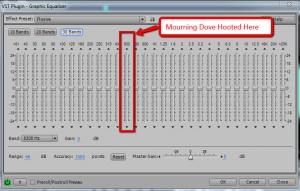
One other piece of good fortune was that a small amount of the dove noise was sounding during a section when the voice was not talking. It wasn’t enough to sample into a noise-reduction effect (unfortunately – because that is another good way to filter out the bad while leaving the good). So I highlighted the small bit of audio that had ONLY the mourning dove hoot in it. Then I opened the Graphic Equalizer tool in Adobe Audition (I still use version 3, but Audition is also part of Adobe CC – Adobe Audition CC [Digital Membership]
Awesome. Now that I knew that this particular mourning dove hooted at 500 Hz, I went back to the audio with both the voice AND the bird hooting in it, and highlighted that section. Then I just opened the Graphic Equalizer and started moving the slider at 500 Hz down, which turns down the volume at just that frequency. Now voices also produce sound at 500 Hz, so it I turned things down too much, the voice would also be affected. But in this case, by the time I moved the slider down enough to get rid of the dove, the voice still sounded fine. It probably helped that it was a female voice.
And the bird was gone! the entire process took about 60 seconds, which is a lot less time than it would have taken me to re-record the voice.
So the next time you have a bird outside your window threatening to ruin your recording session, remember this method. It might save you time and money. Of course, you could always build you own vocal isolation booth to record in. But that’s another topic altogether.
Some More EQ Tips For Music Mixing – 7 Important Frequencies
I just read another post that you might want to bookmark. It is about using equalization (EQ) when mixing music – a very common topic, but something that takes a lot of practice to get right. People usually do too much with EQ at first. Then with experience, when you realize exactly why you are using EQ and what it’s doing to your audio, you start to understand that a subtle use of this tool is how you get the best results. One really useful reference guide to have handy when using EQ is a description of what frequencies affect what types of instruments and elements of your song. For example, it is super handy to know that bass guitar is around 80-100 Hz, or that the human voice is primarily in the 2-3 KHz area. Knowing where the different instruments and sound “live” on the frequency spectrum is pretty important stuff.
This post has a list of seven EQ frequency bands that you might want to print out and tape to something near your computer:
http://productionadvice.co.uk/using-eq/
What Is Multiband Compression?
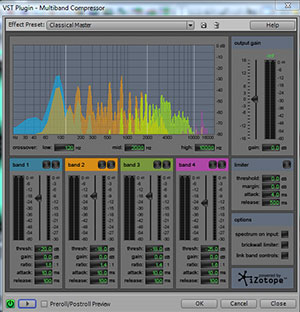 Multiband compression is an incredible audio tool if you can get past the fact that it, like many other terms in audio, is a bit scary and technical sounding. It’s mainly used when mastering a song (see our article Mastering a Song – What Does It Mean? for a review of what mastering means), when everything is all mixed together and you only have one audio file. To understand what multiband compression is, you should first have a good idea what regular old compression is.
Multiband compression is an incredible audio tool if you can get past the fact that it, like many other terms in audio, is a bit scary and technical sounding. It’s mainly used when mastering a song (see our article Mastering a Song – What Does It Mean? for a review of what mastering means), when everything is all mixed together and you only have one audio file. To understand what multiband compression is, you should first have a good idea what regular old compression is.
In two previous articles, I wrote about compression basics – Improve Or Ruin Your Audio With an Effect Called Compression and Should You Use Compression In Audio Recording? So if you’re feeling a little rusty on your understanding, give those a quick read.
So back to our question – what is multiband compression? Assuming we know that compression means “turning down” audio loudness ONLY when it gets louder than a certain volume (i.e. the singer’s voice goes happily along with no volume reduction; but during that part in the chorus where he screams, it gets louder than the “threshold” you set on the compressor. So just during the screaming parts, the compressor turns the volume down), multiband compression does the same thing, but we get more control over which frequencies get compressed. Simple right?
Multiband Compression Versus EQ
OK, how about an example? If we have already mixed a song down (so it’s just one file now with all the instruments blended together), and it sounds fabulous except the bass sounds too loud for the song, we have two choices. We can try to use an equalizer effect to lower only certain frequencies (see our post What is Equalization, Usually Called EQ? for more on that). But equalizers turn down (or up) the volume at a targeted frequency or set of frequencies (or “band” or frequencies) regardless of how loud they are. Remember that a compressor won’t turn something down until it gets to a certain volume that you deem to be the place it should be turned down (called a “threshold”). So maybe the EQ isn’t controlling the bass, the low frequency parts of the song as much as you want. So now what?
Well, if you have a multiband compressor (like the one pictured above, which is the iZotope multiband compression plugin that came with Adobe Audition 3), you can apply compression to JUST the low frequency, bass-y frequencies (most compressors operate across the entire frequency spectrum). Unlike an EQ, a compressor will allow everything to play with no volume reduction until it goes past the threshold volume level. So maybe your bass is all good except for one note that keeps popping out of the mix. Or maybe 80 percent of the song has a good bass mix, but during the pre-choruses, things start swimming in bass. A multiband compressor that is ONLY targeting bass frequencies will not do anything until those pre-choruses, which trigger the compression to start reducing bass. Then when the pre-chorus is over, and the bass drops back below the threshold, the compressor stops compressing; that is until the next time some bass notes get too loud, and then it kicks in again, etc. So in a way, a multiband compressor is sort of like EQ in that you can target certain frequency bands (more like a graphic EQ than a parametric EQ in that way). But since compression is different in that it only affects the audio above a specified loudness threshold, it may well be able to solve a problem that EQ cannot.
The multiband compressor plugin shown in the picture above allows you to set 4 different bands. You can just drag the lines on the graph that determine the border between two bands to select how you want to divide things up. Once you do that, you have all the normal compressor controls (threshold, ratio, etc.) available for each band, which you can now set individually and independently of the others. So you could apply a lot of compression in the bass range, say everything from 150 Hz down, while applying no compression at all to a mid-range band of 150 to 800 Hz, mildly compressing high mids of 800Hz to 2KHz, and not compressing anything above 2KHz – all simultaneously with one effect.
Mainly Used While Mastering
When a song is in the mixing stage, each instrument has its own track. So if the bass is too uneven, you can simply stick a compressor on the bass guitar track to even it out. And if the kick drum is interfering with the bass guitar, you can compress and/or EQ just the kick drum track. The same is true for every other frequency range. Maybe there is excess sibilance on the lead vocal. OK, just put an EQ on the lead vocal track and subtract loudness in the sibilance range, typically 4-8 KHz (for a review on sibilance and how to treat it, see our post How to Fix SSS-Sibilance in Your Audio With Sound Editing Software). If a guitar (or any instrument) is harsh and grating on your ears, you can put an EQ or compressor on the guitar track and treat that problem on that track. The point is that you can isolate the problem audio sources and treat them surgically on their own tracks.
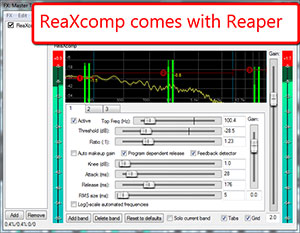 However, a mastering engineer receives “mixed down” audio (see our post What Does It Mean to Mix Down Audio?), all the instruments are already blended together into one file, so you cannot treat JUST the bass guitar, or JUST the lead vocal anymore. It’s like making a cake. Once everything is done and frosted, if you notice there was too much almond extract used in the recipe, well it’s too late to do anything about that. But a mastering engineer can come close to isolating elements of a mixed-down song (cake) using EQ and multiband compression, and may actually be able to reduce the almond extract flavor even after the cake is baked – to stretch that metaphor a little:).
However, a mastering engineer receives “mixed down” audio (see our post What Does It Mean to Mix Down Audio?), all the instruments are already blended together into one file, so you cannot treat JUST the bass guitar, or JUST the lead vocal anymore. It’s like making a cake. Once everything is done and frosted, if you notice there was too much almond extract used in the recipe, well it’s too late to do anything about that. But a mastering engineer can come close to isolating elements of a mixed-down song (cake) using EQ and multiband compression, and may actually be able to reduce the almond extract flavor even after the cake is baked – to stretch that metaphor a little:).
If you would like to try a multiband compressor, and you already have Reaper recording software, you’re in luck! One of the many effects plug-ins that come with Reaper is ReaXcomp, a multiband compressor. Most 3rd party MBC plug-ins cost at least $200 and go up from there. So the fact that you get one free with Reaper is pretty amazing. If you don’t already have Reaper, go download it now for free (http://www.cockos.com/reaper/download.php). They have a 60-day trial that is fully functional. And when the trial is done, you only pay $60 for the license. Then if you make $20,000 per year using their software, you pay for the commercial license for $250. And it’s all on the honor system! All versions of the software – trial, personal license, and commercial license – are identical and fully functional.
So now you know. Multiband compression is just a compressor that lets you apply different settings to different frequencies all at the same time. Go forth and create better music.
Cheers!
Ken
EQ Basics
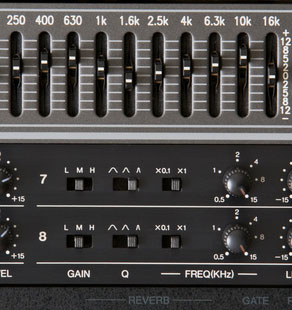 Equalization (EQ) is a big part of mixing and mastering, but for a new audio engineer it may be difficult to grasp the concepts that are involved with using EQ effectively. And because we are all about making hard concepts easy to understand, often by mocking overly complex terms or those who love to use them, but mostly making things fun and making them so anyone can understand.
Equalization (EQ) is a big part of mixing and mastering, but for a new audio engineer it may be difficult to grasp the concepts that are involved with using EQ effectively. And because we are all about making hard concepts easy to understand, often by mocking overly complex terms or those who love to use them, but mostly making things fun and making them so anyone can understand.
I’ve written several articles about EQ, starting at the beginning with What is Equalization, Usually Called EQ? If you can’t get enough of my awesome EQ writing (shya:)), you can find all post about equalization on our site here: https://www.homebrewaudio.com/tag/eq/
There’s a lot to be gained from learning by doing, but having a basic idea of what your goals are and what tools are available can improve the learning curve. And you can also learn EQ stuff from people other than me. I know! It’s a shock. But seriously…
You can read a great step-by-step guide to getting started with EQ here: http://audio.tutsplus.com/tutorials/production/the-basics-of-equalization/